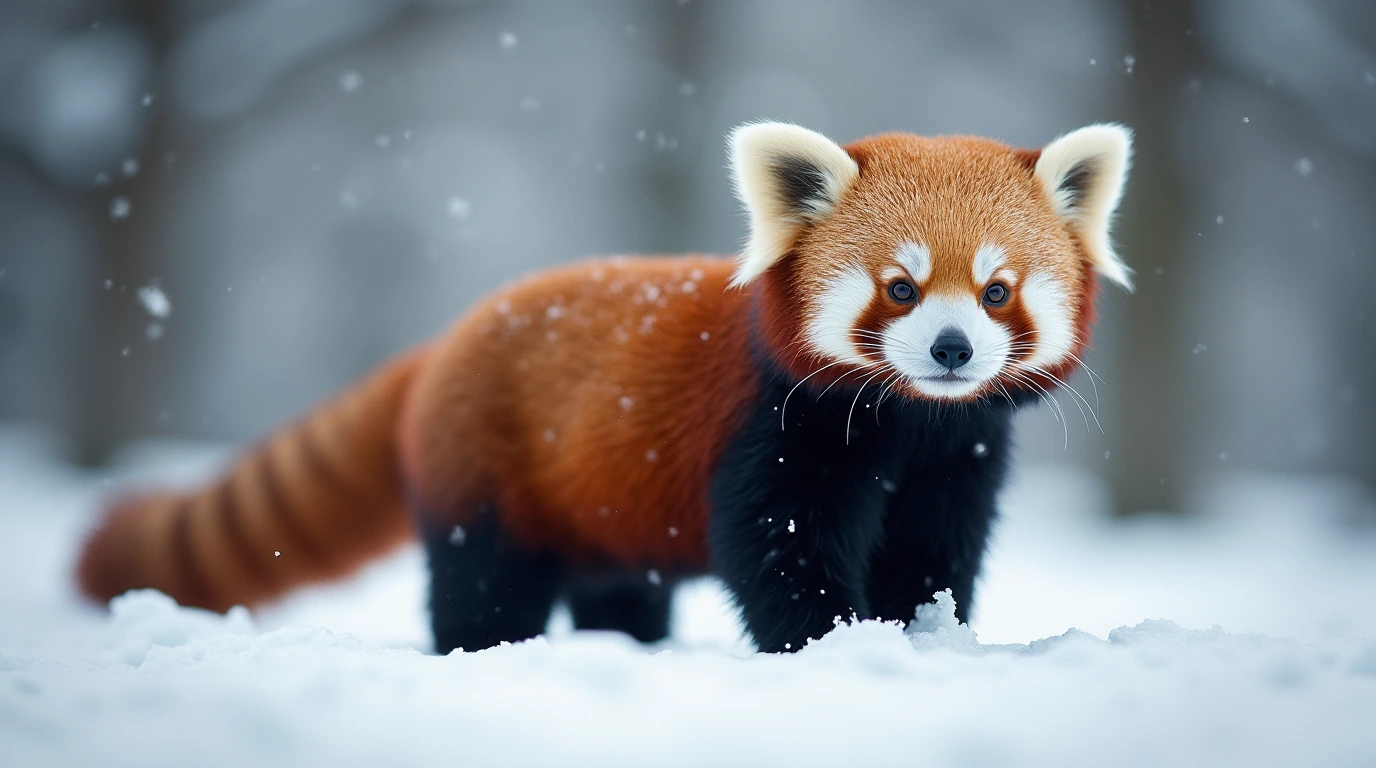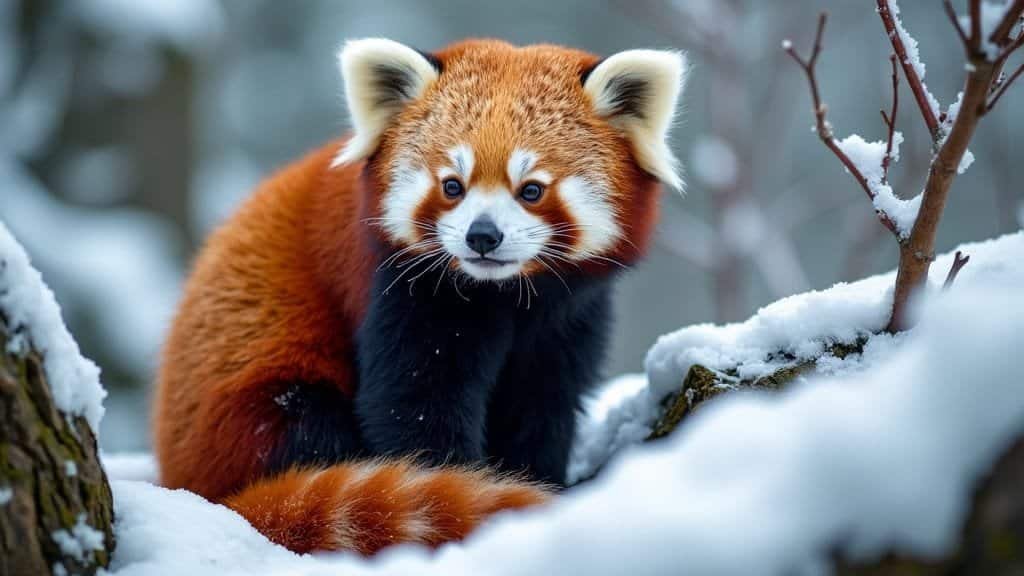The red panda’s thick fur is one of its most vital adaptations for surviving in the cold, mountainous forests of the Himalayas and southwestern China. Living at elevations ranging from 7,200 to 15,700 feet (2,200–4,800 meters), red pandas endure freezing temperatures, heavy snowfall, and strong winds. To stay warm, they rely on their dense fur coat, which acts as a natural insulator by trapping body heat and preventing moisture from penetrating their skin
This specialized fur consists of two layers: a soft, woolly undercoat that provides warmth and a coarse outer layer that repels water and snow. Their bushy tail plays an additional role in heat conservation, wrapping around their bodies like a blanket when they sleep. Even their footpads are covered in fur, allowing them to walk on icy surfaces without losing body heat
In this article, we will explore how red pandas use their fur to survive extreme conditions, compare their adaptations to other cold-weather mammals, and examine the impact of climate change on their ability to regulate body temperature. Understanding these natural defenses provides insight into how red pandas have thrived in one of the world’s most challenging environments
How Red Pandas Stay Warm in Cold Environments

Red pandas are specially adapted to survive in the harsh, cold climates of the Himalayas, where temperatures can drop well below freezing. Their thick fur coat plays a critical role in insulation, protecting them from the cold while allowing them to remain active in snowy and icy conditions. This fur is not only dense but also structured in a way that maximizes heat retention
The Insulating Properties of Red Panda Fur
The fur of a red panda consists of two distinct layers, each serving a specific purpose in keeping the animal warm. The inner layer is made up of a soft, woolly undercoat that traps body heat, preventing warmth from escaping in freezing temperatures. This undercoat functions similarly to the insulation found in cold-weather gear, creating a buffer against extreme weather. Covering this inner layer is a coarse outer coat made of longer guard hairs, which provide protection against wind, snow, and moisture
Unlike many animals that rely on fat reserves to generate warmth, red pandas depend almost entirely on their fur for insulation. Their entire body is covered in fur, including their ears and footpads, reducing heat loss from exposed skin. The fur on their paws not only keeps them warm but also improves traction, allowing them to navigate icy branches without slipping
The reddish-brown coloration of their coat also plays a role in heat absorption. While their fur primarily provides insulation, the darker hues help absorb sunlight, further aiding in maintaining body temperature. This adaptation is particularly useful on bright, sunny winter days when red pandas can bask in sunlight while resting on tree branches
Comparing Red Panda Fur to Other Cold-Weather Mammals
Red pandas share many fur adaptations with other mammals that thrive in cold climates, yet their unique arboreal lifestyle sets them apart. Unlike bears, which rely on fat deposits along with thick fur to retain body heat, red pandas maintain a relatively lean body and use their fur as their primary defense against the cold. Snow leopards, another cold-adapted species in the Himalayas, have long, dense fur, but they are primarily terrestrial hunters, whereas red pandas spend most of their time in trees
Unlike Arctic foxes and wolves, which have oily fur that repels water, red pandas rely more on the structural properties of their fur to stay dry. Their outer layer of guard hairs helps prevent snow from sticking to their bodies, but their fur is not fully waterproof. This means that during heavy snowfall, they must seek shelter under tree canopies or in hollows to avoid excessive moisture exposure
Another key difference between red pandas and other cold-weather mammals is their fur-covered footpads. While many carnivores have exposed toe pads that are resistant to freezing, red pandas have fully furred feet, which insulate them from cold surfaces. This adaptation is particularly useful for navigating snowy branches and climbing in icy conditions
The Role of the Tail in Heat Conservation
One of the most distinctive features of the red panda is its long, bushy tail, which provides an additional layer of insulation during cold weather. Measuring up to 18 inches (46 cm) in length, the tail is covered in thick fur and marked with alternating red and buff-colored rings
When temperatures drop, red pandas curl into a tight ball and wrap their tails around their bodies like a built-in blanket. This behavior helps them conserve body heat by reducing exposure to cold air and shielding their noses from freezing temperatures. The tail’s fur is just as dense as the rest of their body, ensuring that they remain warm even in extreme winter conditions
Beyond its role in warmth, the tail also serves as an important balancing tool. Since red pandas spend most of their lives navigating tree branches, the tail provides stability and prevents them from falling. This is especially useful in icy conditions when climbing surfaces become slippery
The combination of balance support and thermal insulation makes the tail an essential survival feature for red pandas in their mountainous habitat. For more insights into how red pandas adapt to snowy environments, including how their fur and tail function in extreme weather, you can explore the Red Panda Network
How Red Panda Fur Protects Against Cold and Moisture

Red pandas face a combination of freezing temperatures, heavy snowfall, and damp conditions in their mountainous habitat. Their fur not only provides warmth but also serves as a protective barrier against moisture, preventing cold-related stress and ensuring they remain active even in harsh weather
How Red Panda Fur Repels Snow and Water
Red pandas are frequently exposed to snowfall, yet their fur is designed to keep them dry and insulated. The outer layer of their coat consists of coarse, long guard hairs that help repel moisture. Unlike some animals that produce oily secretions to waterproof their fur, red pandas rely on the density and structure of their fur to keep water from penetrating their undercoat. When snow lands on their back, it often slides off instead of melting and soaking into their fur
Despite this natural protection, red pandas still seek shelter in tree hollows or dense vegetation during heavy rain or snowfall. They instinctively avoid prolonged exposure to wet conditions, as damp fur can lead to heat loss. In captivity, red pandas are often provided with dry, insulated resting areas to mimic their natural behavior of finding protective cover
Seasonal Changes in Red Panda Fur Thickness
Red pandas experience seasonal variations in their fur thickness, allowing them to adjust to changing temperatures throughout the year. In the winter, they develop an extra-thick undercoat that provides maximum insulation, helping them withstand subzero conditions. As temperatures rise in the spring and summer, they shed some of this dense fur to avoid overheating
This shedding process helps regulate their body temperature while maintaining the protective qualities of their outer coat. Even in warmer months, their fur remains relatively thick compared to other mammals, ensuring that they are still prepared for cooler nights and sudden weather shifts in their high-altitude environment
Environmental Strategies Red Pandas Use to Stay Warm
Beyond their fur adaptations, red pandas use behavioral strategies to enhance their warmth. One of the most common methods is curling into a tight ball while sleeping, a posture that minimizes heat loss and maximizes insulation. This position allows them to trap warm air close to their body while shielding their face and extremities from the cold
Another strategy involves seeking out natural windbreaks, such as tree hollows, rocky crevices, or dense bamboo thickets. These locations provide additional protection from strong winds and freezing temperatures, reducing the need for their bodies to generate excess heat. Red pandas are also known to bask in the sunlight during colder months, using natural heat sources to supplement their fur’s insulation
Captive red pandas display similar behaviors, often preferring enclosed resting areas that provide a sense of security and warmth. Zoos and conservation centers ensure that enclosures include a variety of shaded and sheltered spaces, allowing red pandas to regulate their exposure to environmental conditions
For further insights into the insulating properties of red panda fur and how it helps them survive in cold climates, you can explore the Smithsonian’s National Zoo
Climate Challenges and the Future of Red Panda Adaptation

While red pandas have evolved a dense fur coat to survive the freezing temperatures of the Himalayas, climate change and habitat disruptions are altering their environment. Rising temperatures, deforestation, and changing snowfall patterns present new challenges that could impact their ability to regulate body heat effectively. Understanding how these factors affect red pandas is crucial for conservation efforts aimed at protecting the species in a rapidly changing world
Differences in Fur Thickness Between Wild and Captive Red Pandas
Wild red pandas experience seasonal changes in their fur thickness, adapting to the fluctuating temperatures of their natural habitat. During winter, their undercoat becomes denser, providing insulation against extreme cold. In warmer months, they shed excess fur to prevent overheating while maintaining the protective properties of their outer coat. These natural adaptations allow them to survive in high-altitude forests, where temperatures can vary significantly between seasons
In captivity, red pandas often experience more stable temperatures, leading to less variation in fur thickness. Zoos and conservation centers regulate enclosures with climate control systems, ensuring that red pandas are not exposed to extreme heat or cold. As a result, captive red pandas may not develop the same thick winter coats as their wild counterparts. However, they still retain their natural fur structure, including the dense undercoat and fully furred footpads
Although captive environments offer protection from harsh weather, they also pose challenges in maintaining natural behaviors. Zoos must carefully balance temperature regulation while allowing red pandas to express their instinctive responses to seasonal changes, such as seeking shade in summer or curling up for warmth in winter
How Climate Change Threatens Red Pandas’ Fur Adaptations
Climate change is a growing threat to red pandas, affecting both their habitat and their ability to regulate body temperature. Rising global temperatures are causing shifts in Himalayan ecosystems, leading to less snowfall, earlier seasonal warming, and an overall increase in temperature extremes. Since red pandas rely on their thick fur for insulation, warmer conditions may result in heat stress, making it more difficult for them to stay cool
In higher-altitude forests where red pandas thrive, temperature increases can disrupt their natural behavioral patterns. Warmer winters may reduce the need for dense winter coats, potentially altering their natural shedding cycle. Prolonged exposure to unseasonably warm conditions could also impact their ability to find suitable resting spots, as they typically seek out shaded tree canopies to escape heat
Deforestation further exacerbates these challenges by removing the dense bamboo forests that provide red pandas with natural shelter. With fewer trees and vegetation to shield them from temperature fluctuations, red pandas may become more vulnerable to the effects of climate change. Conservationists emphasize the importance of protecting their habitat to ensure that red pandas can continue to rely on their natural adaptations
Conservation Efforts to Protect Red Pandas in a Warming Climate
To safeguard red pandas from the threats posed by climate change, conservation organizations are focusing on habitat protection, reforestation efforts, and climate adaptation strategies. Protecting and restoring forests is a top priority, as maintaining tree cover helps regulate local temperatures and provides red pandas with essential shelter. Conservation groups are also working with local communities to reduce deforestation and establish wildlife corridors that allow red pandas to migrate to cooler, higher-elevation habitats if needed
In captivity, zoos and breeding programs are implementing measures to ensure that red pandas remain comfortable in changing conditions. Temperature-controlled enclosures, shaded areas, and cooling systems help prevent heat stress while still allowing red pandas to experience seasonal changes. By replicating natural temperature fluctuations, zoos can support red pandas’ instinctive responses to different climates, ensuring they continue to develop their natural fur adaptations
Despite these challenges, ongoing conservation efforts offer hope for the future of red pandas. By addressing the impacts of climate change and protecting their habitats, scientists and conservationists are working to ensure that red pandas can continue to rely on their thick fur to survive in their cold mountain homes
For more details on red panda conservation and their adaptations to climate, you can explore the International Fund for Animal Welfare (IFAW)













